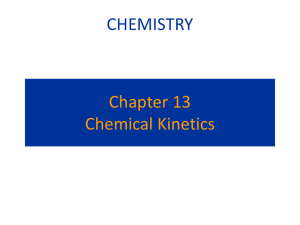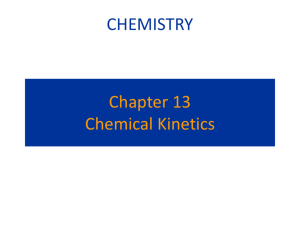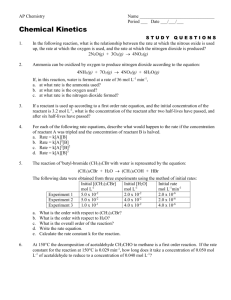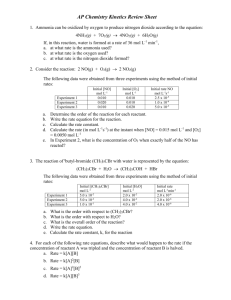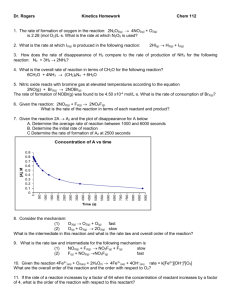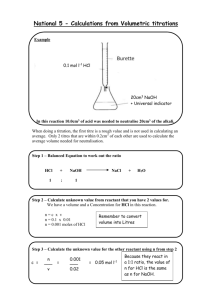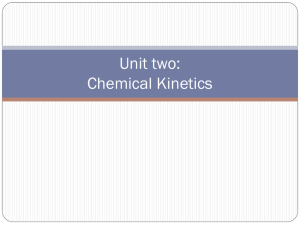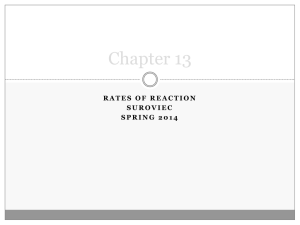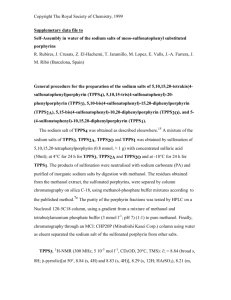1 - Gordon State College
advertisement
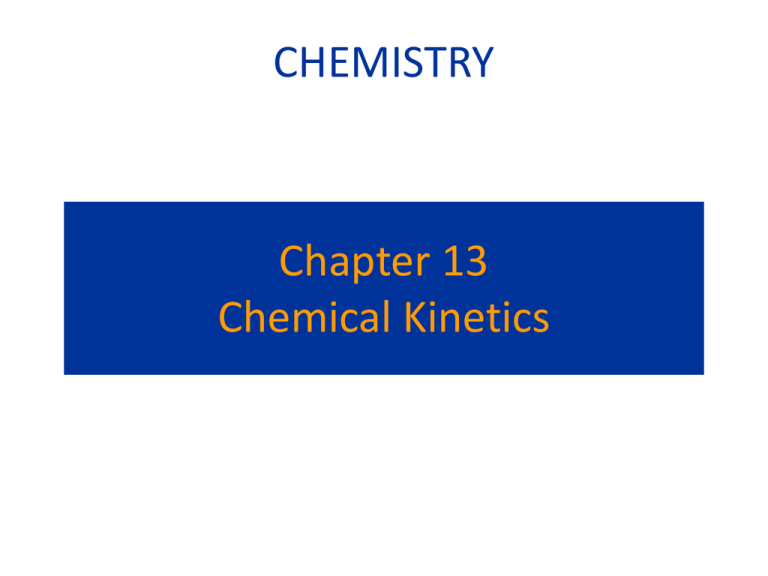
CHEMISTRY Chapter 13 Chemical Kinetics Factors that Affect Reaction Rates • Kinetics is the study of how fast chemical reactions occur. • There are 4 important factors which affect rates of reactions: – – – – reactant concentration, temperature, action of catalysts, and surface area. • Goal: to understand chemical reactions at the molecular level. Reaction Rates Change of Rate with Time • Consider: C4H9Cl(aq) + H2O(l) C4H9OH(aq) + HCl(aq) Reaction Rates • For the reaction A B there are two ways of measuring rate: – the speed at which the products appear (i.e. change in moles of B per unit time), or – the speed at which the reactants disappear (i.e. the change in moles of A per unit time). moles of A Average rate with respect to A t Reaction Rates Reaction Rate and Stoichiometry • In general for: aA + bB cC + dD 1 A 1 B 1 C 1 D Rate a t b t c t d t Problem 1 In the Haber process for the production of ammonia, N2(g) + 3H2(g) 2NH3(g) What is the relationship between the rate of production of ammonia and the rate of consumption of hydrogen? 2N2O5(g) 4NO2(g) + O2(g) At a particular instant rate of (N2O5) = 4.2 x 10−7 mol·L−1·s−1 What are the rates of appearance of NO2 and O2 ? Problem 3. Consider the reaction 4PH3(g) P4(g) + 6H2(g) If, in a certain experiment, over a specific time period, 0.0048 mol PH3 is consumed in a 2.0-L container each second of reaction, what are the rates of production of P4 and H2 in this experiment? Take Note! • Since the direction of equilibrium changes as more product is produced, rates have to be determined as soon as the experiment has begun. This is why…….. • …… even if the rate of production of product is of interest, rate expression still uses the starting reagents. 2N2O5 4NO2 + O2 [N2O5] (mol/L) Time (sec) 0.100 0 0.0707 50 0.0500 100 0.0250 200 0.0125 300 0.00625 400 • Rate is (-) if reagent is consumed. • Rate is (+) if compound is produced. • Rate will ultimately be (+) because change in concentration will be negative. Two (-)’s become (+). Differential Rate Law - is a rate law that expresses how rate is dependent on concentration Example: Rate = k[A]n Differential First Order Rate Law • First Order Reaction – Rate dependent on concentration – If concentration of starting reagent was doubled, rate of production of compounds would also double Concentration and Rate • • • • Using Initial Rates to Determines Rate Laws A reaction is zero order in a reactant if the change in concentration of that reactant produces no effect. A reaction is first order if doubling the concentration causes the rate to double. A reacting is nth order if doubling the concentration causes an 2n increase in rate. Note that the rate constant does not depend on concentration. Differential Rate Law • For single reactants: A C Rate = k[A]n • For 2 or more reactants: A + B C Rate = k[A]n[B]m Rate = k[A]n[B]m[C]p Problem • NH4+ • • • • + NO2- N2 + 2H2O Give the general rate law equation for rxn. Derive rate order. Derive general rate order. Solve for the rate constant k. To Determine the Orders of the Reaction (n, m, p, etc….) • 1. Write Rate law equation. • 2. Get ratio of 2 rate laws from successive experiments. • Ratio = rate Expt.2 = k2[NH4+]n[NO2-]m rate Expt.1 k1[NH4+]n[NO2-]m • 3. Derive reaction order. • 4. Derive overall reaction order. Experimental Data [NO2-]initial Initial Rate Expt. [NH4]initial 1 0.100 M 0.0050 M 1.35 x 10-7 2 0.100 M 0.010 M 2.70 x 10-7 3 0.200 M 0.010 M 5.40 x 10-7 A+BC Experiment Number [A] (mol·L-1) [B] (mol·L-1) Initial Rate (mol·L-1·s-1) 1 0.100 0.100 4.0 x 10-5 2 0.100 0.200 4.0 x 10-5 3 0.200 0.100 1.6 x 10-4 (a) Determine the differential rate law (b) Calculate the rate constant (c) Calculate the rate when [A]=0.050 mol·L-1 and [B]=0.100 mol·L-1 Use the data in table 12.5 to determine 1) The orders for all three reactants 2) The overall reaction order 3) The value of the rate constant 2NO(g) + 2H2(g) N2(g) + 2H2O(g) Experiment Number [NO] (mol·L-1) [H2] (mol·L-1) Initial Rate (mol·L-1·s-1) 1 0.10 0.10 1.23 x 10-3 2 0.10 0.20 2.46 x 10-3 3 0.20 0.10 4.92 x 10-3 (a) Determine the differential rate law (b) Calculate the rate constant (c) Calculate the rate when [NO]=0.050 mol·L-1 and [H2]=0.150 mol·L-1 Sample Problem:. Consider the general reaction aA + bB cC and the following average rate data over some time period Δt: Δ[A] 0.0080 mol L1 s1 Δt Δ[B] 0.0120 mol L1 s 1 Δt Δ[C] 0.0160 mol L1 s1 Δt Determine a set of possible coefficients to balance this general reaction. Problem • Reaction: A + B C obeys the rate law: Rate = k[A]2[B]. • A. If [A] is doubled (keeping B constant), how will rate change? • B. Will rate constant k change? Explain. • C. What are the reaction orders for A & B? • D. What are the units of the rate constant? You now know that…. • The rate expression correlates consumption of reactant to production of product. For a reaction: 3A 2B - 1[A] = 1[B] 3 t 2 t • The differential rate law allows you to correlate rate with concentration based on the format: Rate = k [A]n You also know that… • 1. Rate of consumption of reactant decreases over time because the concentration of reactant decreases. Lower concentration equates to lower rate. • 2. If a graph of concentration vs. time were constructed, the graph is not a straight line Expt. 25 1400 1200 Time in seconds 1000 800 Series1 600 400 200 0 0 0.002 0.004 0.006 0.008 Concentration (M) 0.01 0.012 0.014 Expt. 25 0.014 Concentration in Molarity 0.012 0.01 0.008 Series1 0.006 0.004 0.002 0 0 200 400 600 800 Time in seconds 1000 1200 1400 How can we make the line straight? What is the relationship between concentration and time? By graphing concentration vs. 1/time? Concentration vs. Reciprocal of Time 0.006 Reciprocal of Time (1/sec) 0.005 0.004 0.003 Series1 0.002 0.001 0 0 0.002 0.004 0.006 0.008 Concentration (M) 0.01 0.012 0.014 The Integrated Rate Law makes this possible! First Order Reaction -3 0 200 400 600 800 1000 1200 1400 1600 -3.5 ln[concentration] -4 -4.5 Series1 -5 -5.5 -6 -6.5 Time in seconds Integrated Rate Law • Expresses the dependence of concentration on time Integrated Rate Laws • Zero Order: [A]t = -kt + [A]o • First Order: ln[A]t = -kt + ln[A]o • Second Order: 1 [A]t = kt + 1 [A]o where [A]o is the initial concentration and [A]t is the final concentration. Integrated First-Order Rate Law • ln[A]t = -kt + ln[A]0 • Eqn. shows [concn] as a function of time • Gives straight-line plot since equation is of the form y = mx + b The Change of Concentration with Time Zero Order Reactions •A plot of [A]t versus t is a straight line with slope -k and intercept [A]0. The Change of Concentration with Time First Order Reactions •A plot of ln[A]t versus t is a straight line with slope -k and intercept ln[A]0. The Change of Concentration with Time Second Order Reactions •A plot of 1/[A]t versus t is a straight line with slope k and intercept 1/[A]0. Integrated Rate Law 2N2O5 NO2 + O2 Rate = - [N2O5] = k[N2O5] n t If n = 1, upon integration: ln [N2O5]t = -kt + ln [N2O5]0 initial concentration at t=0 2N2O5 4NO2 + O2 [N2O5] (mol/L) Time (sec) 0.100 0 0.0707 50 0.0500 100 0.0250 200 0.0125 300 0.00625 400
